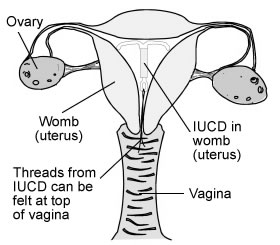Intrauterine Contraceptive Devices, IUCD
An IUCD is a small device placed inside the uterus to prevent pregnancy. It is also known as ‘the coil’. There are two threads attached to the IUCD which pass out through the neck of the womb (cervix) and lie in the vagina. These allow the IUCD to be removed easily. You can also check whether the IUCD is in place by feeling for the device’s thread in your vagina.
Most devices are T-shaped. The commonly used IUCD are made of plastic wound with copper wire (copper IUCD). There are also hormone-releasing IUCD (Mirena). IUCD are usually effective for 5 to 10 years.
It works mainly by interfering sperm and egg migration and embryo implantation.
IUCDs are very effective. Only 1-2 of every 100 women using the IUCD will become pregnant over five years of use.
Advantages of IUCD:
- Effective long-term birth control
- Does not interfere with sex or sex drive (libido)
- No side-effects of systemic hormonal method (contraceptive pills or injectables), i.e. it will not affect your mood, weight or libido
- If you have heavy or painful periods, hormone-releasing IUCD (Mirena) is an effective treatment for heavy or painful periods.
Disadvantages of IUCD:
Although the majority women with an IUCD have no problems, the following may occasionally occur:
- Heavy, painful periods
- This tends to be in the first few months after insertion and then often settles.
- If you already have heavy or painful periods, hormone-releasing IUCD (Mirena) is advised which is an effective treatment for heavy or painful periods.
- Infection
There is a small risk of an infection of the uterus (pelvic infection) when you have an IUCD inserted. The main risk of infection is within the first 20 days after insertion. You should not have an IUCD inserted if you have an infection which has not been treated. - Ectopic pregnancy
IUCD is very effective at preventing intrauterine pregnancy. However, if you do become pregnant, there is a risk of having an ectopic pregnancy (a pregnancy in the Fallopian tube and not in the uterus). See a doctor urgently if you miss a period and you develop lower abdominal pain. - Expulsion
Rarely the IUCD may come out without your noticing. This may happen during a period, most commonly in the first few months after fitting. It is a good idea to check you can feel the threads of the IUCD after your period. If the IUCD has come out, you should use extra precautions such as a condom until you have seen your doctor. - Damage to the womb
The fitting of an IUCD can very rarely make a small hole in the womb – this is called perforation. It protrudes through the wall of the womb and can escape into the pelvis. This happens in fewer than 2 women per 1000, usually at the time of fitting. An ultrasound scan will be carried out to find a lost IUCD. If ultrasound does not find the IUCD, an X-ray will be ordered.
Insertion of the IUCD must be performed by a doctor. It can be fitted at any time provided that you are not pregnant, usually during the first 5 days of period. Your doctor will do a vaginal examination to check the size and position of the uterus. The IUCD is then fitted using a small plastic insertion device. Fitting an IUCD can sometimes be uncomfortable. Once the IUCD has been inserted, some women have crampy pains like period pains for a few hours (and up to 48 hours) afterwards. You may also have light vaginal bleeding for a short while.
A follow up will be arranged after the next period to check if there is any problem after fitting an IUCD. If you want to get pregnant, the IUCD can be removed anytime.
Please consult our doctor if you are planning to use an IUCD.

Reference:
http://www.cdc.gov/reproductivehealth/unintendedpregnancy/contraception.htm



